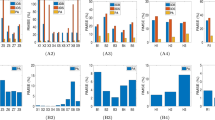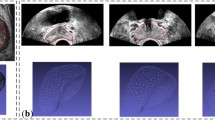Abstract
Mechanical property characterization of prostate tumors can enhance the results obtained by palpation by providing quantitative and precise diagnostic information to surgeons. The multi-focal characteristics of prostate tumors cause inhomogeneity and local property variance in the prostate glands, which is one reason for inaccurate property characterizations of the tumors. Therefore, biomechanical models should include inhomogeneity and local property variance by taking into consideration the anatomical information (location and volume) of the tumors. We developed six inhomogeneous local prostate models using the finite element method, which takes into account the location and volume information of prostate tumors. The models were divided into six different sections: lateral apex, lateral mid, lateral base, medial apex, medial mid and medial base tumors. Information on the location and volume of prostate tumors was obtained using pathological analysis. The mechanical properties of prostate tumors were estimated using the developed model simulation and the ex vivo indentation experiment results from the human resected prostates. The results showed that the mean elastic moduli of the normal and tumoral regions were 14.7 and 41.6 kPa, respectively. Our models provided more reliable estimates of the elastic moduli than the conventionally used Hertz–Sneddon model, and the results from our model were more closely correlated with previous studies due to the inclusion of the anatomical information via inhomogeneous modeling. These six local models provide baseline property criteria for the diagnosis and localization of prostate tumors using the optimized elastic moduli of normal prostate tissues.






Similar content being viewed by others
References
Ahn B, Kim J (2010) Measurement and characterization of soft tissue behavior with surface deformation and force response under large deformations. Med Image Anal 14:138–148
Ahn B, Kim J, Lorenzo EIS, Rha KH, Kim HJ (2010) Mechanical property characterization of prostate cancer using a minimally motorized indenter in an ex vivo indentation experiment. Urology 76:1007–1011
Ahn BM, Kim J, Lorenzo EIS, Lah KH, Kim H (2010) Mechanical property characterization of prostate cancer using a minimally motorized indenter in an ex vivo indentation experiment. Urology 76(4):1007–1011
Ahn B, Lee H, Park K, Lee J, Rha K, Kim J (2011) Robotic system for hybrid diagnosis of prostate cancer: design and experimentation. In Proceedings of IEEE international conference on robotics and automation, Shanghai, China, pp 6276–6281
Ahn BM, Kim YJ, Oh CK, Kim J (2012) Robotic palpation and mechanical property characterization for abnormal tissue localization. Med Biol Eng Comput 50(9):961–971
Carson WC, Gerling GJ, Krupski TL, Kowalik CG, Harper JC, Moskaluk CA (2011) Material characterization of ex vivo prostate tissue via spherical indentation in the clinic. Med Eng Phys 33(3):302–309
Chonan S, Jiang ZW, Tanaka M, Kato T, Kamei M (1998) Development of a palpation sensor for detection of prostate cancer and hypertrophy (optimum structural design of sensor). Int J Appl Electromagn 9:25–38
Cox MAJ, Driessen NJB, Boerboom RA, Bouten CVC, Baaijens FPT (2008) Mechanical characterization of anisotropic planar biological soft tissues using finite indentation: experimental feasibility. J Biomech 41(2):422–429
Faria EC, Ma N, Gazi E, Gardner P, Brown M, Clarke NW, Snook RD (2008) Measurement of elastic properties of prostate cancer cells using AFM. Analyst 133(11):1498–1500
Galosi AB, Montirini R, Fabiani A, Lacetera V, Galle G, Muzzonigro G (2009) Cystic lesions of the prostate gland: an ultrasound classification with pathological correlation. J Urol 181:647–657
Hollenstein M, Nava A, Valtorta D, Snedeker J, Mazza E (2006) Mechanical characterization of the liver capsule and parenchyma biomedical simulation. In: Harders M, Székely G (eds) Springer, Berlin, pp 150–158
Hoyt K, Castaneda B, Zhang M, Nigwekar P, Sant’Agnese PAD, Joseph JV, Strang J, Rubens DJ, Parker KJ (2008) Tissue elasticity properties as biomarkers for prostate cancer. Cancer Biomarkers 4:213–225
Jonathan IE (1995) Diagnostic criteria of limited adenocarcinoma of the prostate on needle biopsy. Hum Pathol 26(2):223–229
Kim Y, Kim M, Shin JH, Kim J (2010) Characterization of cellular elastic modulus using structure based double layer model. Med Biol Eng Comput 49(4):453–462
Krouskop TA, Wheeler TM, Kallel F, Garra BS, Hall T (1998) Elastic moduli of breast and prostate tissues under compression. Ultrason Imaging 20(4):260–274
Liu H, Noonan DP, Althoefer K, Seneviratne LD (2008) Rolling mechanical imaging: a novel approach for soft tissue modelling and identification during minimally invasive surgery. In: Proceeding of the 2008 IEEE international conference on robotics and automation, Pasadena, CA, USA, pp 845–850
Liu H, Noonan DP, Challacombe BJ, Dasgupta P, Seneviratne L, Althoefer K (2010) Rolling mechanical imaging for tissue abnormality localization during minimally invasive surgery. IEEE Trans Biomed Eng 57(2):404–414
Lweesy K, Fraiwan L, Al-Batainehm O, Hamdi N, Dickhaus H (2009) Optimization of ultrasound array designs for high intensity focused treatment of prostate cancer and benign prostatic hyperplasia. Med Biol Eng Comput 47:635–640
Mettlin C, Lee F, Drago J, Murphy GP (1991) Findings on the detection of early prostate cancer in 2425 men. Cancer 67(12):2949–2958
Mor JJ (1997) The Levenberg–Marquardt algorithm: implementation and analysis. Springer, Berlin, pp 105–116
Potter SR, Horniger W, Tinzl M, Bartsch G, Partin AW (2001) Age, prostate-specific antigen, and digital rectal examination as determinants of the probability of having prostate cancer. Urology 57(6):1100–1104
Sangpradit K, Liu H, Seneviratne LD, Althoefer K (2009) Tissue identification using inverse finite element analysis of rolling indentation. In: Robotics and automation, ICRA ‘09. IEEE International Conference, NJ, USA, pp 1250–1255
Schwenninger D, Schumann S, Guttmann J (2011) In vivo characterization of mechanical tissue properties of internal organs using endoscopic microscopy and inverse finite element analysis. J Biomech 44(3):487–493
Tadayyon H, Lasso A, Kaushal A, Guion P, Fichtinger G (2011) Target motion tracking in MRI-guided transrectal robotic prostate biopsy. IEEE Trans Biomed Eng 58:3135–3142
Tanaka M, Kamei M, Furubayashi M, Jiang ZW, Tanahashi K, Chonan S (1999) Development of a palpation sensor for detecting prostate cancer and hypertrophy (signal processing on clinical data). Trans Jpn Soc Mech Eng 65:3296–3301
Tanaka M, Furubayashi M, Tanahashi Y, Chonan S (2000) Development of a palpation sensor for detection of prostate cancer and hypertrophy. Smart Mater Struct 9:878–884
Yan J, Scott PK, Fearing RS (1999) Inclusion probing: signal detection and haptic playback of 2D FEM and experimental data. In: Proceedings of IMECE. Nashville, Tennessee, USA, pp 203–210
Yang THJ, Leung SKW, Phipps S, Reuben RL, Mcneill SA, Habib FK, Schnieder A, Stevens R (2006) In vitro dynamic micro-probing and the mechanical properties of human prostate tissues. Technol Health Care 14(4):281–296
Zhao R, Wyss K, Simmons CA (2009) Comparison of analytical and inverse finite element approaches to estimate cell viscoelastic properties by micropipette aspiration. J Biomech 42:2768–2773
Acknowledgement
This work was supported by the National Research Foundation of Korea (NRF) grant funded by the Korea government (MEST) (No. 2012-0001007).
Author information
Authors and Affiliations
Corresponding author
Additional information
Y. Kim and B. Ahn contributed equally.
Rights and permissions
About this article
Cite this article
Kim, Y., Ahn, B., Lee, J.W. et al. Local property characterization of prostate glands using inhomogeneous modeling based on tumor volume and location analysis. Med Biol Eng Comput 51, 197–205 (2013). https://doi.org/10.1007/s11517-012-0984-7
Received:
Accepted:
Published:
Issue Date:
DOI: https://doi.org/10.1007/s11517-012-0984-7




